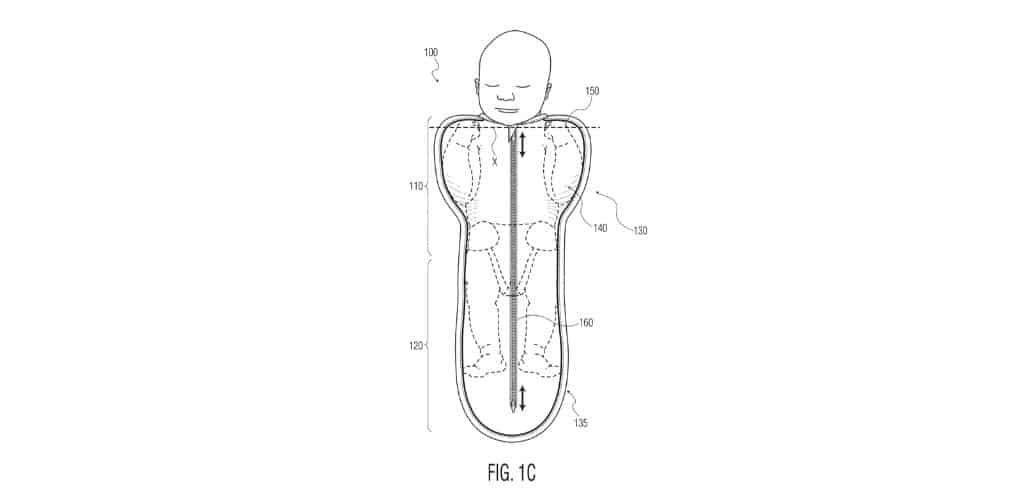The Director of the US Patent and Trademark Office (USPTO) granted rehearing and modified the Final Written Decision of the Patent Trial and Appeal Board (PTAB) after finding that the patentability of a multiple dependent claim should be considered separately as to each of the claims from which it depends.
In Nested Bean, Inc. v. Big Beings US Pty. Ltd. et al., Nested filed a petition requesting inter partes review (IPR) of claims 1–18 of Big Being’s U.S. Patent No. 9,179,711 B2.
The patent at issue is for a baby swaddling suit, shown above.
Claims 1 and 2 of the ʼ711 patent are independent and claims 3–16 are multiple dependent claims, which depend directly or indirectly from either claim 1 or 2.
As the USPTO notes, claims define the invention and what aspects are legally enforceable.
- A claim may be written in independent or dependent form.
- An independent claim is a standalone claim that contains all the limitations necessary to define an invention.
- A dependent claim must refer to a claim previously set forth and must further limit that claim.
In January 2021, the PTAB granted institution of IPR and issued a Final Written Decision that determined that Nested didn’t establish by a preponderance of evidence that claims 1, 17, and 18 were unpatentable. The PTAB further determined that Nested did establish by a preponderance of evidence that claims 2–16 were unpatentable.
In response, Big Being filed a Request for Director review, arguing that
claims 3–16 are multiple dependent claims that each depend from claim 1 or 2, and the Board found that Petitioner failed to show by a preponderance of the evidence that claim 1 is unpatentable. As a result, the Board should have found that Petitioner likewise failed to show by a preponderance of the evidence that claims 3–16 — as depending from claim 1 — are unpatentable [under pre-AIA 35 U.S.C. § 112, fifth paragraph].
Pre-AIA 35 U.S.C. § 112, fifth paragraph (which only applies to patent applications filed before September 16, 2012) states:
A claim in multiple dependent form shall contain a reference, in the alternative only, to more than one claim previously set forth and then specify a further limitation of the subject matter claimed. A multiple dependent claim shall not serve as a basis for any other multiple dependent claim. A multiple dependent claim shall be construed to incorporate by reference all the limitations of the particular claim in relation to which it is being considered.
USPTO Director Katherine Vidal granted this request for review, asking the parties to address:
- whether the interpretation of 35 U.S.C. § 112, fifth paragraph, governing multiple dependent claiming on which Patent Owner relies is an issue of first impression, and
- if so, the legislative history, appropriate statutes, and regulations, as well as any policy issues or persuasive authority, and
- if not, any authoritative case law specifically concerning Patent Owner’s interpretation.
In her Decision, Vidal noted that the PTAB’s consideration of multiple dependent claim patentability as to each of its alternatively referenced claims was an issue of first impression before the PTAB.
She concluded that
the plain language of 35 U.S.C. § 112, fifth paragraph, requires that the patentability of a multiple dependent claim is considered separately as to each of its alternatively referenced claims.
Thus, she said, the PTAB erred in determining that claims 3– 16, as dependent from claim 1, are unpatentable.
She wrote:
The plain language of 35 U.S.C. § 112, fifth paragraph, communicates that a multiple dependent claim is the equivalent of several single dependent claims. Thus, in the same way that the unpatentability of multiple single dependent claims would each rise or fall separately, so too should the dependent claims covered by a multiple dependent claim. 37 C.F.R. § 1.75(c) further supports that interpretation because each alternatively referenced claim of a multiple dependent claim incurs a separate dependent claim fee, i.e., each version of a multiple dependent claim is charged as a stand-alone dependent claim and, so, suggests separate treatment.
Just like the haiku above, we like to keep our posts short and sweet. Hopefully, you found this bite-sized information helpful. If you would like more information, please do not hesitate to contact us here.


